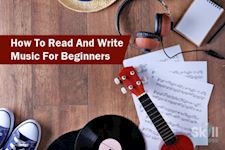How To Read And Write Music
Skill Success
Summary
- Certificate of completion - Free
- Tutor is available to students
Add to basket or enquire
Overview
This course includes lifetime access so you can complete the course at your own speed.
By taking this course today, you can advance your musical talents and skills by learning how to read and write music even if you are a beginner!
Benefits of taking this course include:
- Unlimited and lifetime access to the course
- Learn the course at your own pace
- Course can be accessed on any platform
- 24/7 Customer support
Course media
Description
Learning how to read and write music can be one of the most beneficial steps in improving your skills.
This is a comprehensive course intended for beginners wanting to learn how to read and write music. Through 6 sections and 84 video lectures, you will learn how to read and write music.
This How To Read And Write Music course will cover the following topics:
Topic 1 - Course Overview & Welcome
- Your Brain On Music
- Music & The Brain
- Fur Elise Piano Score
Topic 2 - Who, What, When, Where, Why & How
- What Is A Written Note?
- Six Key Questions
- From Say To Play
- From 6 to 3
- What To Play – Pitch
- When To Play -Value & Duration
- How To Play – Signs & Symbols
- Recap So Far!
- 2D Music Model
- 3D Music Model
- Onto The Page
Topic 3 - What To Play
- Pitch
- Treble Clef
- Bass Clef
- Grand Staff
- Treble Clef Lines
- Treble Clef Spaces
- Bass Clef Lines
- Bass Clef Spaces
- Half Steps & Recap
- Rhymes & Mnemonics
- Guido’s Hands & Resources
- Middle C4 & Ledger Lines
- Octaves & Frequency Doubling
- Ledger Line Tips & Tricks
- In Context – Fur Elise
Topic 4 - When To Play
- Whole Note – Semibreve
- Half Note – Minim
- Quarter Note – Crotchet
- Eighth Note – Quaver
- Sixteenth Note – Semiquaver
- 1/32nd Note – Demisemiquaver
- 1/64th Note – Hemidemisemiquaver
- Table Of Note Values
- Relative Note Values – Circular Chart
- Rests
- Dotted Notes & Rests
- Tied Notes
- Note Parts
- Equal Terms (American/European)
- Measures & Barlines
- Time Signatures
- Compound Time
- Irregular Time Signatures
- Definition Of Terms
- Hierarchy Of Beats
- Eastman Counting System
- Triplets & Duplets
- Rhythmic Examples
Topic 5 - How To Play
- Major & Minor Keys
- Chords – Maj Min Dim Aug
- Chords -Inversions
- Major Scales -Formula
- Relative Minor Scales
- Accidentals – Sharp Flat & Natural Signs
- The Harmonic Minor Scale
- The Melodic Minor Scale
- Legato & Staccato
- Recap So Far
- Musical Terms – Signs & Symbols
- Writing Conventions
- Why Flat? Why Not Sharp?
Topic 6 - Deconstructing Fur Elise
- Deconstruction
- Fur Therese?
- Bagatelle
- Beethoven’s Intent
- Clef & Key
- Time Signature & Dynamics
- Pedal & Marking Up The Score
- Accidentals & Rests
- Editorial Markings & Bar Numbers
- Double Barlines. Repeat Signs & 1st & 2nd Endings
- Dotted Notes. Clef Change. Ledger Lines.
- Chords. Flats. Ornaments. Eastman (Counting)
- Slurs & Phrasing
- Beyond The Page
Topic 7 - Course Conclusion
Who is this course for?
This course is designed for anyone who is interested in learning how to read and write music.
Requirements
No prior knowledge is required to take this course.
Questions and answers
Currently there are no Q&As for this course. Be the first to ask a question.
Certificates
Certificate of completion
Digital certificate - Included
Reviews
Legal information
This course is advertised on reed.co.uk by the Course Provider, whose terms and conditions apply. Purchases are made directly from the Course Provider, and as such, content and materials are supplied by the Course Provider directly. Reed is acting as agent and not reseller in relation to this course. Reed's only responsibility is to facilitate your payment for the course. It is your responsibility to review and agree to the Course Provider's terms and conditions and satisfy yourself as to the suitability of the course you intend to purchase. Reed will not have any responsibility for the content of the course and/or associated materials.


